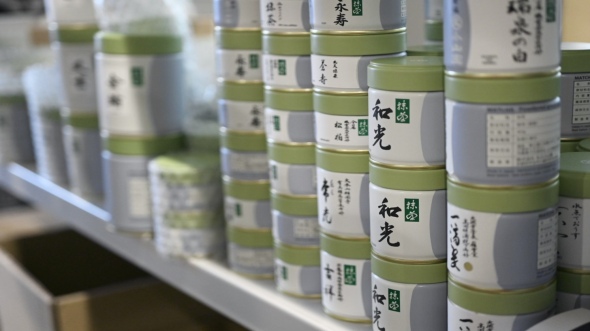Vo******, UKRAINE ► "Thank you" Pa******, ARGENTINA ► "Agnes is very responsive and works out any problem you might have." Da******, CZECH REPUBLIC ► "Perfect packaging, quick delivery, great service. Thank you" An******, UNITED STATES OF AMERICA ► "I love it!" AN******, ► "I received the package in 10 days as it was written. Thank you very much, I am happy for the gift, the free sample , it was a nice surprise..Also the packaging was fine for safe delivery of the products. Thank you so much!" Da******, UNITED STATES OF AMERICA ► "Sazen is excellent. I’m glad they got this new Kanbayashi line, it gives sweeter matcha lovers like me a good complement to the Maryuku Koyamaen line. I’ll continue to buy both. If you describe your preferences in taste, Sazen is quite good at making recommendations - they are an excellent matcha “sommelier”!" Da******, UNITED STATES OF AMERICA ► "Perfect as always!" mi******, ROMANIA ► "Superb tea and service, thank you." LE******, UNITED STATES OF AMERICA ► "EXCELLENT, ALWAYS ON TIME" Ro******, GERMANY ► "One of the best tea resellers currently available for international (and, in particular, EU) customers. Literally, only the positive experience!" Th******, UNITED STATES OF AMERICA ► "From the moment I placed my order, I felt valued as a customer. They were quick to respond to my questions about the product. When I had a concern about the bowl, they immediately addressed it and went above and beyond to ensure my satisfaction.The tea bowl arrived safely and on time, thanks to Sazen Tea's careful packaging. It was clear they took extra care to protect this delicate item during transit.
I can't recommend Sazen Tea and this beautiful Kuroraku Muki Guri Chōjiro Utsushi tea bowl enough. If you're looking for high-quality Japanese teaware and a smooth purchasing experience, look no further. This piece has quickly become a cherished part of my tea ceremony, and I'm already eyeing my next purchase from Sazen Tea!" Mi******, SWITZERLAND ► "Perfect." No******, CANADA ► "Very fast shipping and delivery. Shipping is very expensive." Om******, ISRAEL ► "Szazen service was great and the range of matcha tea is very nice!" El******, UNITED STATES OF AMERICA ► "Amazing service, had not issues and order arrived within date given by shipping service." Ta******, CANADA ► "packed perfectly with care and arrived quickly as always :) worlds best online tea shop." Ez******, PHILIPPINES ► "Marukyu Koyamaen products were out of stock everywhere so I was expecting delays in my shipping but I got my items in a week!" Je******, UNITED STATES OF AMERICA ► "Super fast & accurate!" Lá******, HUNGARY ► "Fast shipping, excellent packaging and lovely staff service." Al******, UKRAINE ► "Fast shipping, safe packaging" Jo******, UNITED STATES OF AMERICA ► "Good as always!" Ma******, ITALY ► "I took time to realize that Sazen is one of the best around . Prompt service, accuracy , I am very proud I have now all I need on a palm of a hand. Thank you for to be so professional." Sz******, ROMANIA ► "Stellar services." Da******, UNITED STATES OF AMERICA ► "Excellent service" Ar******, UNITED STATES OF AMERICA ► "Packaging and timing is good as always, you guys are such a quality service." An******, UNITED STATES OF AMERICA ► "Very quick delivery. Only took 4 days to ship from Japan to the United States." Ch******, UNITED STATES OF AMERICA ► "From prompt shipping to samples in the package I keep coming to Sazen for my tea because the service is the best!" An******, UNITED STATES OF AMERICA ► "They are absolutely the best and very responsive. I place one year’s order at a time." Ma******, POLAND ► "It was nice to shop with Sazentea. great customer service, Agnes is very kind and answears all your questions, I got a lot of samples and a handwritten note :-)" Sa******, ISRAEL ► "Like everytime, service's from Sazen is just at perfection, Thank You :)" Da******, UNITED STATES OF AMERICA ► "Consistent perfection!" Al******, ► "Reliable and quality packaging. Outstanding customer service." Ka******, CROATIA ► "the postal service charged me additional charges for processing, that was not well documented when i selected it." Da******, GERMANY ► "Great communication and fast shipment!" Jo******, UNITED STATES OF AMERICA ► "Great as always!" Hu******, UNITED STATES OF AMERICA ► "Fast shipping and enjoyed the kind words with the packaging. Products were shipped with care." Ca******, PHILIPPINES ► "Thank you for the freebie tea and for fast shipping" Ma******, UNITED STATES OF AMERICA ► "Thank you." Da******, UNITED STATES OF AMERICA ► "Excellent, very safe packaging and delivered 2 days early. Received exactly what I asked for." Xi******, GERMANY ► "Fast, reliable shipping as always!" Al******, JAPAN ► "as one get used to it it become more and more enjoyable and can appreciate its subtle taste" Je******, AUSTRALIA ► "Very good packaging." Ma******, NETHERLANDS ► "Thank you for all the support to ship this item to Europe" KE******, NEW ZEALAND ► "Thanks for the safe packaging." Ch******, UNITED STATES OF AMERICA ► "Fantastic shipping and everything came packed nicely, I didn't even know a package could go from Japan to America this quickly. The signatures and sample of Ogurayama were greatly appreciated too, will definitely be ordering from here again." Sh******, UNITED ARAB EMIRATES ► "Great" Mo******, UNITED STATES OF AMERICA ► "Thanks for the amazing service!" Me******, UNITED STATES OF AMERICA ► "Tea is good and customer service is even better" To******, POLAND ► "Great service, fast delivery, well packed. Nothing to complain, just to praise!" Ta******, CANADA ► "This has to be the best customer service I've ever found in a Tea company, and the packaging is always so secure and safe! I am always surprised at how fast I recieve these precious goods, usually taking just one week, counting the exact day of purchase. I cannot be more pleased with my buying experience here on this website." St******, UNITED STATES OF AMERICA ► "Gokujo Shincha 2020" Al******, ► "Perfect deal! Very efficient and friendly staff. Very good and fast service! I will keep buying in your store." Fa******, UNITED STATES OF AMERICA ► "Professional they truly are. It was a very satisfying experience." Na******, SWITZERLAND ► "Very fast shipping and delivery." Vi******, UNITED STATES OF AMERICA ► "My matcha was packed quickly and arrived safely!" Da******, UNITED STATES OF AMERICA ► "Always perfect!" Er******, UNITED STATES OF AMERICA ► "Packaging was fine, no damage to the matcha tin." Je******, UNITED STATES OF AMERICA ► "Super fast as always and well packaged!" LE******, UNITED STATES OF AMERICA ► "THE BEST!" Ch******, UNITED STATES OF AMERICA ► "Great as usual" Se******, AZERBAIDJAN ► "My favorite online source for the best tea" Da******, UNITED STATES OF AMERICA ► "Always top quality service!" Vl******, UKRAINE ► "Very fast delivery, Japan-Ukraine (7 days), every time gifts, very comfortable site and track information! Thank you!" To******, POLAND ► "Perfect service as always" ha******, CANADA ► "very speedy delivery" Je******, UNITED STATES OF AMERICA ► "Sazen has never let me down! Super fast shipping (faster arriving in US from Japan than some companies shipping inside US!!!), excellent packaging, can't say enough great things!" Ch******, UNITED STATES OF AMERICA ► "The best, and the lunar new years treats were great!" Sz******, SINGAPORE ► "Ordered on Sunday night, received on Thursday night (Singapore)" Ta******, HUNGARY ► "Perfect service, as always!" Me******, MEXICO ► "Everything was well packaged to prevent any damage. It didn´t take long to arrive after posting. The only issue I had was that I received the notification that my package had been sent and was on its way after i had already received it at my adress a few days prior; other than that I have no complaints." Ki******, SINGAPORE ► "Very fast delivery, did not expect that." Ri******, UNITED STATES OF AMERICA ► "Great communication and the same price as the Marukyu vendor in Japan so there is no mark up for international customers which I have experienced while purchasing Marukyu products from local vendors in my country. Very fast shipping." Jo******, UNITED STATES OF AMERICA ► "Great, as always!" Wi******, UNITED STATES OF AMERICA ► "Amazing service as always" LE******, UNITED STATES OF AMERICA ► "I wish you offer in a cans as well, i love them." Sa******, ISRAEL ► "Like everytime, service's from Sazen is just at perfection, Thank You :)" Sa******, INDONESIA ► "I have been buying from Sazen for maybe 5 times now. All the way from Japan, the products arrived safely, and of good quality. I also like the reward points, and very appreciative of the mini free sample Sazen gave in each shipment. In fact, I ended up ordering some that I thought was quite good. Well done!" la******, UNITED STATES OF AMERICA ► "this a really good matcha! Highly underrated! the flavor is spot on comparable to some of the really high end matcha powders! its such a great beginner level matcha I would say slight umami flavor absolutely no bitterness, no astringency and nice grassy notes with little hints of toasted flavor" Jo******, UNITED STATES OF AMERICA ► "Always excellent packaging." Da******, UNITED STATES OF AMERICA ► "Perfect!" St******, UNITED STATES OF AMERICA ► "Gorgeous matcha" Ni******, SWEDEN ► "Great service! Good recommendations and taking time to make it personal was very appreciated." Sz******, ROMANIA ► "Great service, fast and precise." Sa******, ISRAEL ► "Sazen services and products are perfect like everytime ! Thanks for everything :-)" Ma******, UNITED STATES OF AMERICA ► "SAZEN is has become my favorite site to purchase teas and quality tea vessels at reasonable prices. Excellent shipping time and service. Thank you." Ja******, UNITED KINGDOM ► "As always fast, efficient and high standards" Da******, UNITED STATES OF AMERICA ► "Sazen is always great." Fr******, UNITED STATES OF AMERICA ► "Always helpful, always quick response." Cl******, UNITED STATES OF AMERICA ► "Great service as usual" Da******, THAILAND ► "I truly appreciate the packaging of each individual product and of the delivering parcel. The preparation might be a bit longer than expected but it's acceptable." Da******, UNITED STATES OF AMERICA ► "Perfect, AAA+++" Je******, UNITED STATES OF AMERICA ► "Sazen delivers earlier than expected! Thank you Sazen for your hard work!" Wi******, UNITED STATES OF AMERICA ► "Great service, willing to work with me when I made an error in my order. Arrived quickly and was well packed." Ma******, UNITED STATES OF AMERICA ► "DO NOT ORDER FROM SAZEN MY ORDER WAS NEVER DELIVERED AND THEY REFUSE TO REFUND ME" Ar******, UNITED STATES OF AMERICA ► "Splendid" Ch******, SINGAPORE ► "This is the second time I've ordered from Sazen, and both times items were well packed and I was informed at every step of the process." An******, UNITED STATES OF AMERICA ► "Awesome. Will appreciate even more if you can tell me : is it true that as long I keep my total order under 10,000 JPY, I pay no Custom tax in US." So******, UNITED KINGDOM ► "Thank you Sazen! I am enjoying the chigi no shiro cha.
Also thanks for the great communication and information on your website and everything that you sent me ????
It's very interesting learning about different cultivars and tea varieties." Cl******, UNITED STATES OF AMERICA ► "Always great service!!!" Yv******, CANADA ► "Fast shipping/delivery and was super easy with all the information
the website provided. Super reliable!" Ca******, KENYA ► "Excellent" Fe******, ITALY ► "Simply amazing. First time I tried a thencha and wanted to start with a really good one. I followed the brewing suggestion given by Sazen and the result is that I am in love with this tea. Thank you" Ol******, CANADA ► "Perfect customer service with update throughout the process and speedy delivery through DHL services." Ja******, PERU ► "Excellent as always" Ke******, UNITED STATES OF AMERICA ► "Secured site, fast shipping, and good quality products! Repurchasing my second match powder 5 months later." Xi******, SINGAPORE ► "Shipping was fast, items were packaged well. So happy that I can try shin matcha just as it is released." Jo******, UNITED STATES OF AMERICA ► "Good as always!" Ap******, UNITED STATES OF AMERICA ► "Your service feels like home! It is an honor to do business with you!" Ad******, JAPAN ► "The tea is well packaged but would appreciate if you could indicate Company Name clearly on package label as the shipping company could not identify the right office on the floor to deliver to. Thank you!" Jo******, UNITED STATES OF AMERICA ► "Great as always!" An******, GERMANY ► "Simply perfect!" Am******, UNITED STATES OF AMERICA ► "Delivered very fresh with nice packaging. Good price and convenient delivery. Excellent service." Cl******, UNITED STATES OF AMERICA ► "I love your service and the envelopes design are such a nice treat :) love collecting them. Whomever does the art, please let them know is sooo awesome!!!" Je******, UNITED STATES OF AMERICA ► "Super fast and accurate shipping to east coast of US!" Wa******, BRUNEI DARUSSALAM ► "Processing order took a bit of time but fast shipping" Ya******, UNITED STATES OF AMERICA ► "Great service really cheap it's worth it." Be******, SINGAPORE ► "Fast delivery. Item received in good order and well-packed. A free gift was included. Nice gesture" To******, GEORGIA ► "Always impeccable" Sz******, ROMANIA ► "Great service fast shipping, only the description should be more accurate instead of 350 ml capacity correct it to 280 ml and no problem, this is too big of a size difference." To******, POLAND ► "5/5 as always, 0 issues" Er******, UNITED STATES OF AMERICA ► "Everything came perfectly packaged, with no scratches or dents." Ol******, CANADA ► "Great service and efficiency" Ky******, UNITED STATES OF AMERICA ► "Sazen is a great company, I just wish that there were more member perks -- Ideally a spend x amount, and get free shipping perk.. or after spending x amount, get free shipping for a year or something. Matcha is a delicate thing, and I like to order it every month or 2 so I know it's fresh... the shipping costs are killer.." th******, UNITED STATES OF AMERICA ► "super fast" Xi******, SINGAPORE ► "Excellent! Steps were taken to ensure that the matcha cans were delivered intact and met my expectation." Ja******, HONG KONG ► "Thank you for fantastic quality, consistency (2020 vs 2022 Chashoten Gyokuro) and speedy delivery with a rewarding sample gift ^_^" Al******, PHILIPPINES ► "No reply from claim email yet." Ma******, UNITED STATES OF AMERICA ► "Always a great pleasure purchasing from Sazen - their service, packing, products and shipping is unsurpassed. Thank you." Ve******, CROATIA ► "Very quick delivery." Ju******, UNITED STATES OF AMERICA ► "The best I ever had!!!" Wi******, UNITED STATES OF AMERICA ► "Extremely fast shipping, great service." La******, UNITED STATES OF AMERICA ► "It did take about 8 business days to prepare, but once shipped it arrive to East Coast US in 2 days. Totally worth the wait to get authentic matcha for a reasonable price point." Ak******, UNITED STATES OF AMERICA ► "Speedy shipping, and great customer service communication/ problem solving" Jo******, PHILIPPINES ► "thanks for the freebies i apperciate the oriental beauty and the cui feng oolong :) i am really curious with the dong fang mei ren tea then sent it to me :)) thank you" Ba******, PHILIPPINES ► "Excellent service, as always!" Je******, UNITED STATES OF AMERICA ► "Sazen continues to deliver faster than expected and without any issues. Thanks Sazen!!!" Ja******, PERU ► "I love the team" Er******, UNITED STATES OF AMERICA ► "The shipping to USA is pricey, but that’s no fault of Sazen’s. They always include a sample of one of their high quality teas (sometimes even better quality than the ones I ordered) to pique one’s interest." ze******, INDONESIA ► "delivery comes quikly no hassle at all" Ri******, JAPAN ► "Due to a large influx of orders, there were delays in the shipping. BUT, this was clearly communicated on the site, I appreciate this transparency!" Ma******, UNITED STATES OF AMERICA ► "Excellent service as per usual of SAZEN. Arrived safely, intact and in less than 7 days of placing my order. Thank you again for your attention to detail and service - it is a joy to open the boxes that arrive from SAZEN." Au******, UNITED STATES OF AMERICA ► "Great tea and teaware :)" To******, POLAND ► "Perfect service, nothing to complain as always!" Ph******, CANADA ► "Efficient and speedy service. Tea nicely packaged in box. Will purchase from seller again. Very satisfied." Is******, JAPAN ► "Great service from Sazen, but it seems that they're not shipping to Spain anymore :( Hoping they will resume shipping soon." Ly******, CANADA ► "5 star service from Sazen! Will definitely repurchase from them." Ps******, UNITED STATES OF AMERICA ► "best made with room temperature water and no more than 50 ml water steeped for 15 minutes" or******, ISRAEL ► "great company changed my life forever
gave me the opportunity to the best matcha test
but more important the matcha effect of energy realax and focus
very good service
for example i asked for usucha info
the contact sent me info but immediately update iinfo in the website
witch mean he think about every costumer shopping on this store" Ha******, MALAYSIA ► "Excellent service, fast delivery, well packing and thanks a lot for the free gift. Would like to purchase more in the future." An******, UNITED STATES OF AMERICA ► "Thanks for your great service. Carman, Agnes who helped me to select the right matcha for me:(GIN) and promptly answered all my question. Much appreciated your help. Also thanks for the sample of match Ogurayama, delicious." Mi******, UNITED STATES OF AMERICA ► "Wonderful and quick shipment and service. I'm so happy. Thank you!" To******, GEORGIA ► "swift to respond, friendly and professional" Ch******, UNITED STATES OF AMERICA ► "Excellent, thank you for the excellent packaging and the free sample!" Fa******, INDONESIA ► "The product arrived promptly and well packed. Received a nice gift sample too. Thanks for an excellent service, Sazen. Really Appreciate it." In******, UNITED STATES OF AMERICA ► "My package arrived much more quickly than I expected for something shipped overseas!" Sa******, UNITED STATES OF AMERICA ► "Thank you for the excellent service. Item was packed so carefully & arrived SO fast. Can't recommend you guys enough." An******, CYPRUS ► "Took just 2 weeks to arrive all the way to Cyprus! They came all wrapped up and safe, thank you!" Vi******, ISRAEL ► "The product has arrived in excellent condition. It was packed with care." Sa******, UNITED STATES OF AMERICA ► "World-class. Outstanding." Ag******, JAPAN ► "You are amazing guys! Perfect Customer Service ?" Ma******, GIBRALTAR ► "As usual, excellent service!" LE******, UNITED STATES OF AMERICA ► "Very good options on different Japanese and other teas options.
I wish you write on some tea in English, for example , my favor Sencha Agata no Mori has no English description about that tea, which is important. But I thank you for a quick delivery and very best customer service!
Leon.
Miami, Florida, USA" Be******, UNITED STATES OF AMERICA ► "Fast, accurate, packed well, and reasonably priced" Jo******, UNITED STATES OF AMERICA ► "Good as always!" Ca******, CANADA ► "I love sazen. I love the gift they give and their packaging, and how they show the names of their workers. Thank you so much!!" Er******, UNITED STATES OF AMERICA ► "Sazens service was excellent. Arrived surprisingly quick from Japan. They warn while purchasing of potential duty fee's etc, but I never had to deal with any. It arrived via FedEx as any ordinary package." Da******, UNITED STATES OF AMERICA ► "Excellent! Corrected original review from 194C to 194F." Er******, UNITED STATES OF AMERICA ► "Packed very securely with lots of material keeping it from getting smashed." Ma******, CANADA ► "Shipping is fast and carefully packed." An******, UNITED STATES OF AMERICA ► "Fast service and came in pristine condition and packaging. Thank you for the free tea sample included inside." Ba******, PHILIPPINES ► "Again, excellent service Sazen!" Da******, UNITED STATES OF AMERICA ► "Perfect as always!" Th******, UNITED STATES OF AMERICA ► "Excellent shipping and packing." Ky******, UNITED STATES OF AMERICA ► "Always wonderful service from the sazen team. The samples they provide are always wonderful and bring me to my next tea choice" Xi******, GERMANY ► "Absolutely masterpiece! Elegant and lasting design. Bought two some months ago and here I am again stocking three more!" Ju******, UNITED STATES OF AMERICA ► "I love it!!!" Ma******, CANADA ► "My teapot was very carefully packed, thank you." Fa******, INDONESIA ► "Prompt delivery and good customer service. Products are wll packed." To******, POLAND ► "The order came really very carefully packed in a nice coolbox. I received 2 tea samples with my order for which I am also very grateful. This was my first order from Sazen, but I already know that it will definitely not be the last." Ro******, GERMANY ► "Best tea shop! A+++" St******, UNITED STATES OF AMERICA ► "The taste of spring in a cup" Ro******, GERMANY ► "Best team!" Mi******, CANADA ► "Fantastic service and quick delivery." GA******, MALAYSIA ► "Thank you sazen for brings up this wonderful platform for tea lovers" Sc******, UNITED KINGDOM ► "Sazen are always incredible to deal with, their customer support is second to none." Je******, UNITED STATES OF AMERICA ► "Super fast shipping and accurate!" Ri******, UNITED STATES OF AMERICA ► "Fast shipping. Nice original packaging and sazen sticker with details of tea." Je******, UNITED STATES OF AMERICA ► "Always super fast and always packaged with care!" Jo******, UNITED STATES OF AMERICA ► "Great as always!" Cl******, UNITED STATES OF AMERICA ► "Always great service" Je******, UNITED STATES OF AMERICA ► "Super fast & accurate!" Al******, UNITED STATES OF AMERICA ► "Outstanding service, as usual!" Wi******, UNITED STATES OF AMERICA ► "I love sazen tea , very good value" Di******, ISRAEL ► "Thank you for your wonderful service!" BL******, MALAYSIA ► "Well done on detailed description, educating and communication !!" Le******, UNITED STATES OF AMERICA ► "Excellent." Ra******, ALGERIA ► "My order arrived incredibly quickly, exceeding my expectations. The thoughtful touch of including a cute Happy New Year note made the experience feel personal and extra special. It’s clear they care about their customers, and this attention to detail didn’t go unnoticed. Highly recommended for both the efficiency and the warmth of their service!" Mo******, UNITED STATES OF AMERICA ► "excellent service from Sazen as always." Ro******, GERMANY ► "Top service!" Sa******, UNITED STATES OF AMERICA ► "Lovely customer service" Da******, UNITED STATES OF AMERICA ► "I was amazed how fast a package could travel from Japan to the USA without paying a huge shipping rate. And the products are top quality." Ar******, UNITED STATES OF AMERICA ► "Amazing service and packaging as always, always arrives earlier than expected. Beautiful and neat." Tu******, AUSTRIA ► "Quick to respond, very knowledgeable staff" Sh******, UNITED ARAB EMIRATES ► "Great" Da******, UNITED STATES OF AMERICA ► "This was my first purchase from SAZEN and I am extremely pleased. I will definitely be using them again to buy more teas." Ma******, SINGAPORE ► "Very fast n quick delivery by dhl n good service. Reasonable prices." Ma******, IRAN ► "Really professional team ,,
Tnx sazen for support and good service
Peace and love from IRAN" Pi******, POLAND ► "Fast, easy and smooth, those are the words I would use, when it comes to the way how easy and see-through every step of making and order with Sazen is." Mi******, BRUNEI DARUSSALAM ► "delivered the items faster than estimated and received items on the day of the estimated shipping date for the matcha. really great service and quick shipping." To******, GEORGIA ► "My favourite and trusty tea enterprise. Long live" Ar******, UNITED STATES OF AMERICA ► "Amazing as always" Má******, HUNGARY ► "Good packaging, thank you for the gift ?" Sa******, UNITED STATES OF AMERICA ► "Great! Arrived very fast" Ma******, UNITED STATES OF AMERICA ► "Sazen's service, packaging and shipping as per usual is top rate. Thank you." Ni******, BULGARIA ► "My favorite cup. I wish they had 45ml version of this! :( The 25ml ones are too small and this is too big. For me the perfect size is 50ml to the edge (35ml filled). But it's perfect for its size - I don't need a pitcher for my 60ml shibo which is awesome. Sazen's service is awesome - everything was packaged nicely and safely." LE******, UNITED STATES OF AMERICA ► "Would be nice if there is a writing in english...." PI******, THAILAND ► "ส่งเร็ว มีชาแถมมาทุกครั้ง ดีเยี่ยมครับ" NI******, THAILAND ► "smart and fast delivery" Sa******, NEW ZEALAND ► "Absolutely 5 star experience buying from Sazen. Everything was easy, perfectly packaged, and arrived in New Zealand only six days after placing my order. Very happy :) Thank-you." Sv******, ISRAEL ► "Pleasant and courteous service. Always send a sample of tea. Thank you" ar******, UNITED STATES OF AMERICA ► "Sazen has never let me down - even from Japan the package arrives faster than other suppliers within the US - and the packaging is so nice - quality all the way. I don't buy from anyone else if I can help it..." Da******, GERMANY ► "Perfect, as always - thanks a lot!" Sa******, ISRAEL ► "Like everytime, service's from Sazen is just at perfection, Thank You :)" Je******, UNITED STATES OF AMERICA ► "I had been disappointed by another company in Japan selling matcha. Sazen NEVER disappoints!!! Thank you Sazen!!!" To******, POLAND ► "excellent" Ja******, UNITED KINGDOM ► "Fresh fast and still cannot figure out how such successful and fresh well packaged products can make it to the UK so fast amazing keep it up" G******, UNITED STATES OF AMERICA ► "As always Sazen service is excellent!" Sa******, UNITED STATES OF AMERICA ► "World-class. Outstanding." th******, UNITED STATES OF AMERICA ► "Ordered on a Saturday and had tea on hand in Georgia, USA by Wed- Amazingly fast. Included sample was appreciated and excellent." Wa******, UNITED STATES OF AMERICA ► "Sazen has excellent service and a wide selection of teaware at very competitive prices." St******, UNITED STATES OF AMERICA ► "The best culinary matcha - tastes like Kyoto" Ma******, SINGAPORE ► "I am impressed because this matcha is cheap, yet it is smooth n not bitter at all with a little astrigency. Unami n sweetness maynot be as good as the premium range ones but the price is Cheaper than Those repacked ceremonial grade matcha we see on amazon or other websites but taste way better. If the entry level for this brand is this good, i wonder how good will the rest of the matcha taste like. Glad to have found this sazen website. Prices are very reasonable compared locally." Sa******, NEW ZEALAND ► "First time customer, and I am extremely pleased and impressed with Sazen's service. I ordered from New Zealand, and the order was at my house in only six days from submitting my order. Everything was carefully packaged and arrived perfectly. Very good products and prices, and excellent response to my questions as well. Arigatou gozaimasu. HIGHLY RECOMMEND :)" Mi******, UNITED STATES OF AMERICA ► "thank you!" Ka******, UNITED STATES OF AMERICA ► "Solid service as usual" Ta******, HUNGARY ► "Perfect, helpful, fast and big hearted customer service." Je******, JAPAN ► "Excellent service as usual :)" Ma******, ITALY ► "Happy, when someone make his job in professional way is always repaid ! Will order again and again !" Ga******, UNITED STATES OF AMERICA ► "prompt, professional shipping as usual" Da******, UNITED STATES OF AMERICA ► "Always perfect!" Ch******, UNITED STATES OF AMERICA ► "All the teaware I have purchased has made the trip from Japan to the US in perfect condition and the packaging is above and beyond." Si******, THAILAND ► "Great service! Easy to order. Fast delivery." Os******, MEXICO ► "Congratulations to Sazen for his top quality service." Da******, UNITED STATES OF AMERICA ► "Sazen is always great." Ma******, NORWAY ► "Very impressed with my first order from your store. Good job!" Da******, UNITED STATES OF AMERICA ► "Always perfect!" Ch******, UNITED STATES OF AMERICA ► "Great as usual" Da******, UNITED STATES OF AMERICA ► "Perfect!" Ch******, UNITED STATES OF AMERICA ► "As always the shipping is perfect and the packaging is the best. I keep coming back because the tea is good and the teawares are some of the best." Ri******, UNITED STATES OF AMERICA ► "If it weren't for Sazen, I wouldn't be able to discover the amazing world of matcha. The quality and price point is way better than anything offered in the U.S." Ol******, CANADA ► "Sazen's staff shows high standards of promptness and efficiency. I ordered on the 7th of August and received them six days later, on the 13th. Everything was well packed." Sa******, ISRAEL ► "Sazen keep only A+ grade products, the service's is a perfection. Thank You :)" Mi******, SWITZERLAND ► "Perfect." Th******, UNITED KINGDOM ► "First time using Sazen Tea and the experience has been a positive one. Even when I contacted customer service via email, the advisors were informative and helpful. The ordering process was easy with options to pay in USD or JPY, and the shipping was quick and easy once it was dispatched. I would highly recommend Sazen Tea and I would definitely use again." Da******, UNITED STATES OF AMERICA ► "Sazen service - from their email replies to how they pack and ship their boxes - is always superb. Seriously when you get a box via DHL or FedEx (I prefer DHL now for US deliveries) take note of even how perfectly the box is packed and taped. This is a Japanese company doing every step mindfully it seems." Lu******, CZECH REPUBLIC ► "Excellent support with the opportunity to choose my own items" On******, CZECH REPUBLIC ► "Insanely fast shipping in comparison to my experiences with other stores." Le******, UNITED STATES OF AMERICA ► "Perfect, arrived much earlier than expected and in perfect condition." Da******, UNITED STATES OF AMERICA ► "Always the best!" Al******, AUSTRALIA ► "Very fast shipping, and the free loose tea was also a very good freebie." Ni******, CANADA ► "Very fast shipping that was carefully packaged. Look forward to shopping with new tea friends at Sazen again soon." Ma******, ITALY ► "Professional and serious" Nh******, UNITED STATES OF AMERICA ► "Reliable and no-hassle. I could not ask for more." Wi******, UNITED STATES OF AMERICA ► "Great service, willing to work with me and the item was shipped quickly and well packed." mi******, ROMANIA ► "super service !" Ja******, UNITED STATES OF AMERICA ► "Packaging by Sazen was stellar, as usual." Da******, UNITED STATES OF AMERICA ► "Always fast delivery, good packaging, and reasonable prices. They will work with you personally on more complicated orders." Ro******, GERMANY ► "Top service!" Ka******, UNITED STATES OF AMERICA ► "Great service! The tea and other items I ordered were well packaged and arrived quickly (within 1 week of ordering) despite COVID-19 and being shipped to GA, USA." BL******, MALAYSIA ► "I feel the product is a little short of info. I hope to know more about the ingredients used. Is it natural essential oil or synthetic. Was it hand made or machine made and etc. Cheers" Ri******, UNITED STATES OF AMERICA ► "Great communication with fast and safe shipping." ha******, CANADA ► "Agnes was very helpful and patient. Upon request, she sent me pictures of available teapots, and I was able to pick one with a color variation that I liked. Received it 3 days later and made a tea right away.... thank you Sazen ream!" Ko******, JAPAN ► "Excellent service and the sample tea was delicious" An******, NETHERLANDS ► "Great website, fast delivery, huge tea, and teaware selection" LE******, UNITED STATES OF AMERICA ► "Would be nice if there is a writing in english...."Uw******, GERMANY ► "The only one shop in Japan I order my tea direkt. Very fast and best teas!!!! Trustfull" AN******, ► "In Greece shops usually give a small gift to costumers to thank them for buying from them. You did something like that which i appreciated. I suggest just have a little more amount in gifts. Thank you" Na******, CANADA ► "Exceptional. Friendly and caring service. Feeling grateful."Al******, UNITED STATES OF AMERICA ► "Great customer service. Super fast shipping. Excellent packaging. Thank you, Sazen Tea!" GA******, MALAYSIA ► "Thank you Sazen. Top quality packing and speed delivery." Yu******, ISRAEL ► "Service is ok, but I after paying everything on site Fedex requested for me to pay 60$ more on arrival..." Da******, UNITED STATES OF AMERICA ► "Sazen service is always top notch." Al******, UNITED STATES OF AMERICA ► "The kyusu is larger than originally advertised. If it had been accurate I wouldn?t have purchased it. I was told they took the maker for their word and it was likely measured originally for 80% full. This is a very common issue with teapots so I think it?s lazy to not have double checked yourself." Ta******, CANADA ► "I was notified of a capacity change before delivery, and I really appreciated that." An******, UNITED STATES OF AMERICA ► "Very nice packaging and fast delivery" Ja******, UNITED STATES OF AMERICA ► "Amazing and caring will 100% order from again!" To******, POLAND ► "Just 5 stars, perfect service really." Mi******, SWITZERLAND ► "Perfect." Ca******, KENYA ► "Excellent" Br******, UNITED STATES OF AMERICA ► "Customer service and shipping was above and beyond! Thank you!" Al******, UKRAINE ► "Fast delivery" Am******, UNITED STATES OF AMERICA ► "Great packaging and very fast shipping. I cannot recommend the DHL DDP option enough for people in Europe, it eliminates all customs headaches and is pretty cost effective." Jo******, UNITED STATES OF AMERICA ► "Good as always!" Ag******, JAPAN ► "Lovely team and unique products. Quality and care 💕" Wi******, UNITED STATES OF AMERICA ► "Sazen is wonderful , my orders are perfect everytime" Ja******, UNITED KINGDOM ► "Delivery, packaging, amazing and fast 3 stars because it was through the advice from you I baught this don't like it at all. Everything else 10/10" Na******, THAILAND ► "Would rate it a 6 stars if have!" Th******, UNITED STATES OF AMERICA ► "Fast and efficient delivery! Thank you for getting the tea out quickly." Ch******, UNITED STATES OF AMERICA ► "Great as usual!" Mi******, SWITZERLAND ► "So well packed, thank you." mi******, ROMANIA ► "Top Notch Quality !" Sa******, HUNGARY ► "Outstanding. Fast processing, fast delivery, excellent packaging, and beautiful products. I have been wanting to order from Sazen for a while, and I am so glad I finally did. I will likely be ordering most of my tea from Sazen from now on." LE******, UNITED STATES OF AMERICA ► "BEST SERVICE, ESPECIALLY SHIPPING WITHIN A FEW DAYS!" Ri******, UNITED STATES OF AMERICA ► "Fast shipping. Nice original packaging and sazen sticker with details of tea." Ma******, UNITED STATES OF AMERICA ► "Service, mailing and attention to detail in packaging is always so appreciated. It is always a pleasant encounter when purchasing from Sazen. Thank you." Ju******, JAPAN ► "Fast and neat service! Packaging was also nice and I got a small bag of service matcha." Jo******, UNITED STATES OF AMERICA ► "Good as always :)" El******, UNITED STATES OF AMERICA ► "Always great." Sa******, UNITED STATES OF AMERICA ► "Fast and so professional. Thank you!" Mi******, ► "Keep keeping the fineness and quality, please!" GA******, MALAYSIA ► "Thank you Sazen. Top quality packing and speed delivery." Da******, UNITED STATES OF AMERICA ► "Excellent customer service!" Wi******, UNITED STATES OF AMERICA ► "As always, service was fantastic and delivery quick." Jo******, UNITED STATES OF AMERICA ► "Great as always!" Ja******, CHILE ► "Always thankful for your excellent service!" Ma******, UNITED STATES OF AMERICA ► "SAZEN's service is always stellar. Their shipping is very fast and they get your goods out to you in less than a week from the date of your order. packing of fragile items are really thought out, secure and arrives intact and safely. Thank you for the attention to details as week." G******, UNITED STATES OF AMERICA ► "As always sazen service is great." An******, AUSTRALIA ► "Excellent service Thank you very much" Pa******, JAPAN ► "Good service and fast shipping. Highly recommended." Gi******, UNITED STATES OF AMERICA ► "Fast service" Iv******, CROATIA ► "Packed excellently" Al******, UNITED STATES OF AMERICA ► "great service" So******, UNITED KINGDOM ► "Thank you so much for stocking this. Please keep it forever! :)" Ta******, HUNGARY ► "The best service as always" Ro******, CANADA ► "Best service ever..." Gl******, JAPAN ► "Sazen is always a perfect quality service preparing orders and answering to customers." Ps******, UNITED STATES OF AMERICA ► "The finest matcha store on the internet by far. Thank You Sazen KANPAI !!!" Ka******, UNITED STATES OF AMERICA ► "Really nice people and they addressed any questions I had. Also, thanks for the gift! My new matcha home as an Ippodo refugee" Sa******, ► "Excelente servicio y profesionalidad. ?Muchas gracias!" Fr******, CANADA ► "Amazing services!" Jo******, UNITED STATES OF AMERICA ► "Sazentea’s service was as good for this order as it’s always been. Shipping is pricey, but I understand why, and their free shipping on $200+ orders is reasonable considering where it’s coming from and how quickly they get it to me. The fact I live in a day & age where I can get products from Japan in one week is great, but I know this wouldn’t be possible if Sazen wasn’t on top of their game." St******, UNITED STATES OF AMERICA ► "Delicious and rich" Va******, UNITED STATES OF AMERICA ► "Great Service ! Well packed and super fast shipping ! Happy New Year" Ad******, SINGAPORE ► "Sazen is always fast to pack and ship my order with no mistakes." Ja******, UNITED STATES OF AMERICA ► "Service was fast all the way from Kyoto to Florida. Everything was safely packaged and you can tell they care about their customers and encouraging the way of tea." G******, UNITED STATES OF AMERICA ► "The only place I but matcha. Trustworthy and great service." Jo******, UNITED STATES OF AMERICA ► "Good as always!" LE******, UNITED STATES OF AMERICA ► "SUPERIOR SERVICE !" Fr******, CANADA ► "Thank you for the great packaging and free sample. Quick to respond to e-mails." Sa******, ISRAEL ► "Like everytime, service's from Sazen is just at perfection, Thank You :)" Fr******, GERMANY ► "Thanks a lot, it´s really a great chashaku." Ca******, CANADA ► "Thank you Sazen team!! Always excited to receive my package from you! I hope you can add more matcha brands so people can try more matcha." Mi******, CANADA ► "Fantastic service and quick delivery." Wi******, UNITED STATES OF AMERICA ► "Exceptional matcha selection" Ji******, UNITED STATES OF AMERICA ► "Sazen has great prices, great products and AMAZING shipping. Somehow my orders show up at my house in days, I order late on Tuesday and it has arrived by Friday afternoon. No need to monitor my can volume because I know I can order last minute and receive this wonderful product in no time. Items are carefully packaged, arrive undamaged and a small free gift is included." Sh******, UNITED STATES OF AMERICA ► "Very fast shipping. Sazen has been reliable over the years." Ia******, UNITED STATES OF AMERICA ► "Arrived promptly and the sample was delicious." Ba******, PHILIPPINES ► "Excellent as always." Al******, THAILAND ► "Order arrived on time. The package is secured. No damage done to the matcha." Da******, UNITED STATES OF AMERICA ► "Perfect as always and early delivery by DHL." Al******, ROMANIA ► "Prompt service and I have strong confidence in all your products!" Sa******, INDONESIA ► "Love the service and the little package of free gift (tea) that is utterly delightful and smart (as I did order some of green teas that were given to me as samples)" Wa******, UNITED STATES OF AMERICA ► "Very fast ship, very well packed." Fe******, ► "???????? ? ??????? ?? 3 ???!" Sz******, ROMANIA ► "Excellent service, highly recommended to any tea lover." Ja******, UNITED STATES OF AMERICA ► "I can't believe how fast this arrived to Florida from Japan! Everything was in perfect shape and packed with much love and care." Na******, THAILAND ► "Amazing! Would give it 6 stars!!" Sa******, UNITED STATES OF AMERICA ► "Fast and professional" An******, GERMANY ► "Brilliant!!!" Ri******, UNITED STATES OF AMERICA ► "Thanks so much for your incredible service again. I try not to look at how much money I spend on tea from Sazen, but there's a reason I've returned for orders every few months. I've found no tea company across the world that balances excellent customer service, selection, and value the way Sazen does." Gy******, HUNGARY ► "Very fast order processing and shipping. Love the "DDP / All Duties & Taxes paid" option, this way I won't have to bother with local import procedures. At Sazen they really put the Customer first, they are always there to support." Ri******, UNITED STATES OF AMERICA ► "Great description. Fast shipping. Nice original packaging" Ma******, UNITED STATES OF AMERICA ► "Excellent service and shipping time. Thank you also for always including samples. I get to share the samples with my colleagues at work and they are always so appreciative of them, as I am." Jo******, PUERTO RICO ► "Great Service, fast shipping!" Al******, UNITED STATES OF AMERICA ► "Best prices for matcha and my favorite place to shop." Je******, UNITED STATES OF AMERICA ► "Sazen is the best! Super fast shipping and great packaging!"
Summer Tea Party

ICY TEAS, COOL OFFERS / Summer, 2024
Reading time: about 10 minutes
Tea is a wonderful beverage we all know as a refreshing, delicious, hot drink. But in the heat of summer, we are not always in the mood for a warm drink. Luckily, there are several ways to enjoy tea, even if the weather is hot. Let’s learn about how to make cold teas!
Information that is covered:
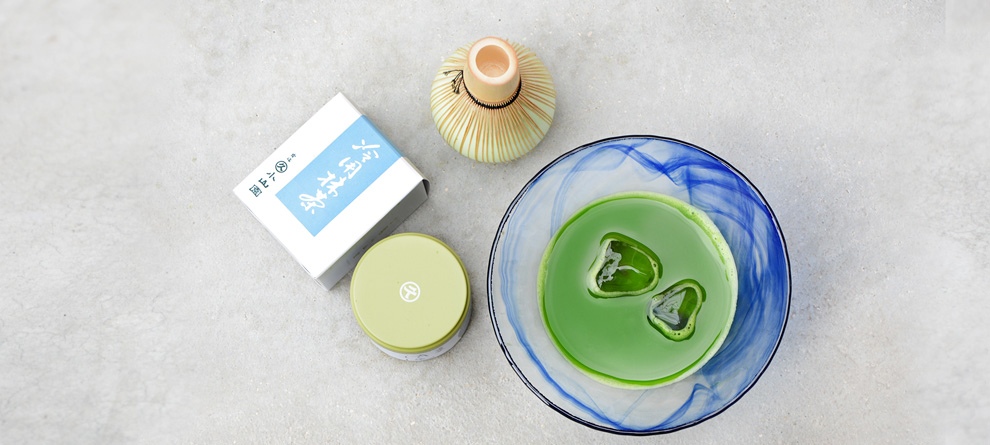
In general, matcha is usually made with hot water. The ideal temperature of the water is essential to make matcha foam well. But there are some matcha teas created with a special technique (freeze-drying) that allows these matcha powders to still foam even if prepared with cold water.
Marukyu Koyamaen offers:
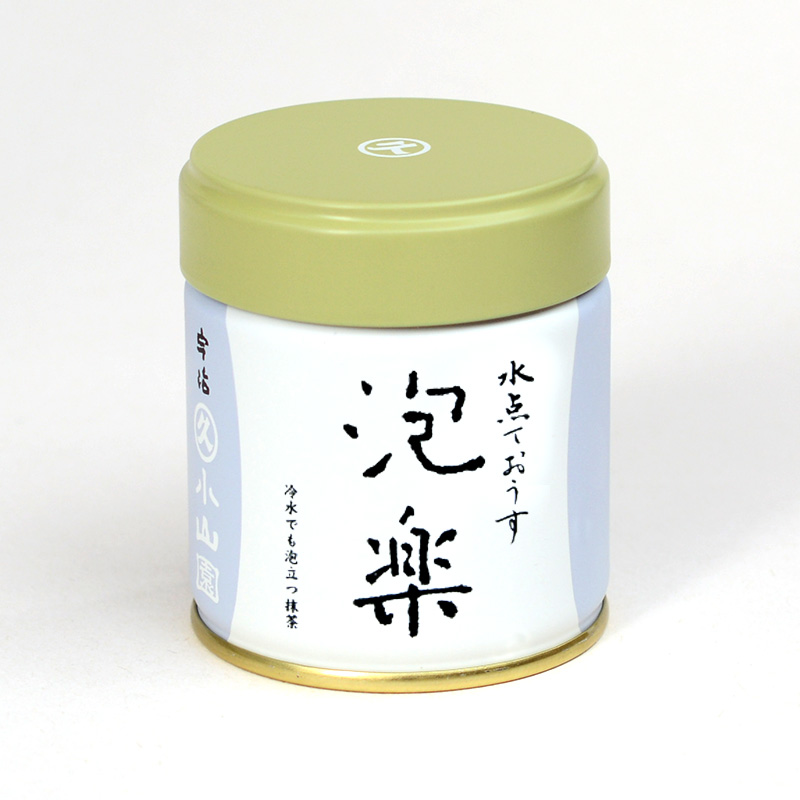 Matcha Awaraku
Matcha Awaraku
Thanks to its freeze-dried producing technology Awaraku does not need to be sifted before making tea, and even though it is suitable for hot matcha, it is more recommended to prepare cold. It has a grassy, fresh taste.
☞ 20 g Branded CAN > $11.88
☞ 40 g Branded CAN > $21.60
☞ 5 x 1.5 g one-cup pouches > $7.56
 Matcha Suzukumo
Matcha Suzukumo
Similar to Matcha Awaraku, Suzukomo was made with freeze-drying technology, needs no sifting, and is best enjoyed when made cold. It is creamy with floral notes.
☞ 20 g Branded CAN > $16.20
☞ 40 g Branded CAN > $30.24
☞ 5 x 1.5 g one-cup pouches > $9.72
We also offer sweetened green tea powders delicious for ice soft drinks:
Matcha sweetened with sugar is characterized by a light, sweet, yet rich flavor. Especially good for cold soft drinks like Matcha Latte or Matcha Lemonade.
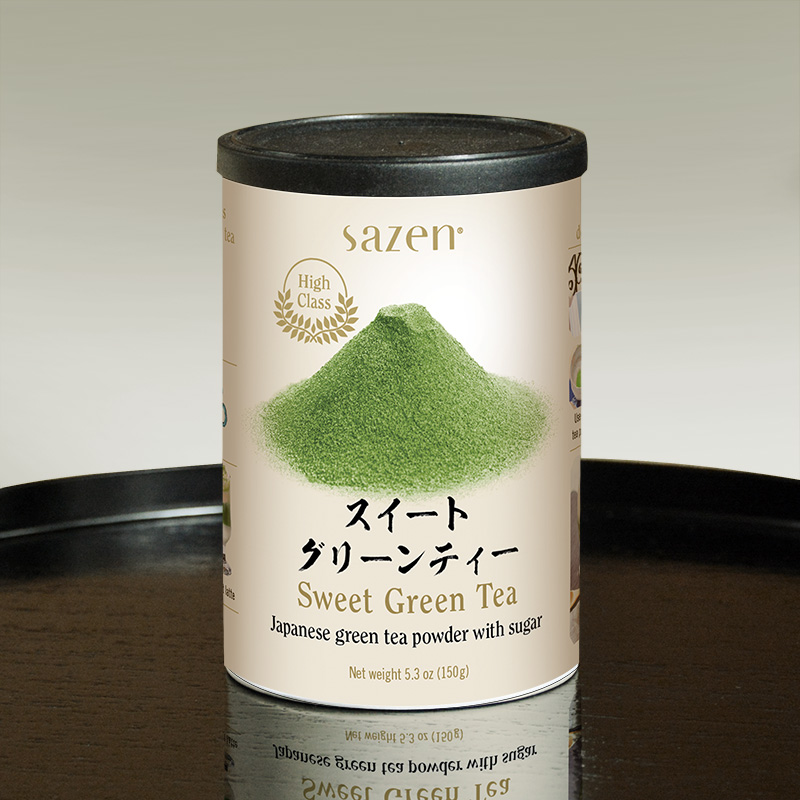 Sweet Green Tea by Hekisuien
Sweet Green Tea by Hekisuien
☞ 120 g Sazen BOX > $8.10
☞ 1000 g BULK > $54
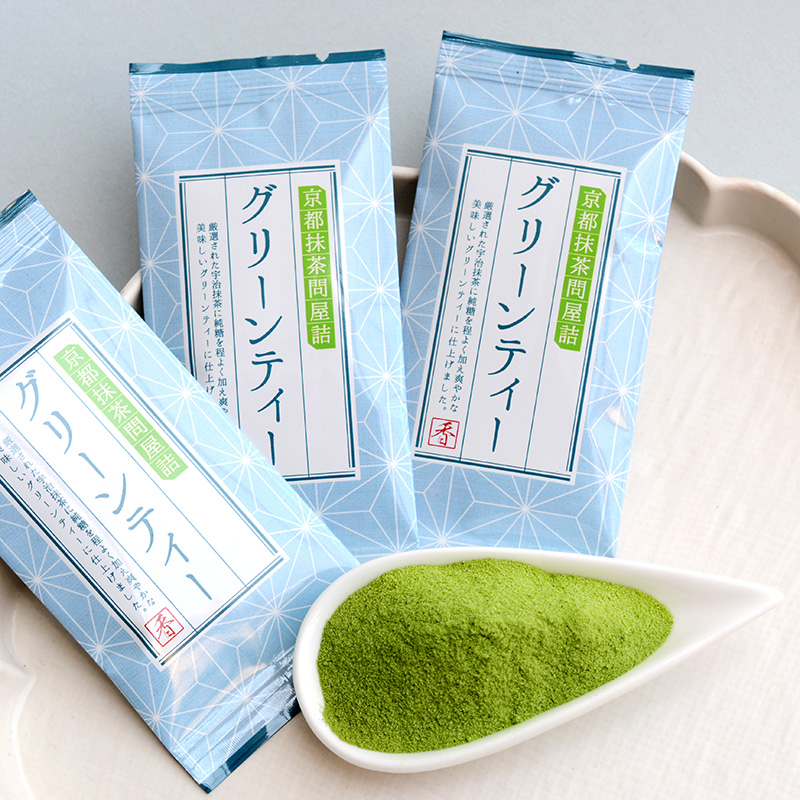
Sweet Green Tea Stick by Hokoen
☞ 10 x 20 g sachets > $12.96
☞ 20 x 20 g sachets > $24.62
☞ 100 x 20 g sachets > $116.64
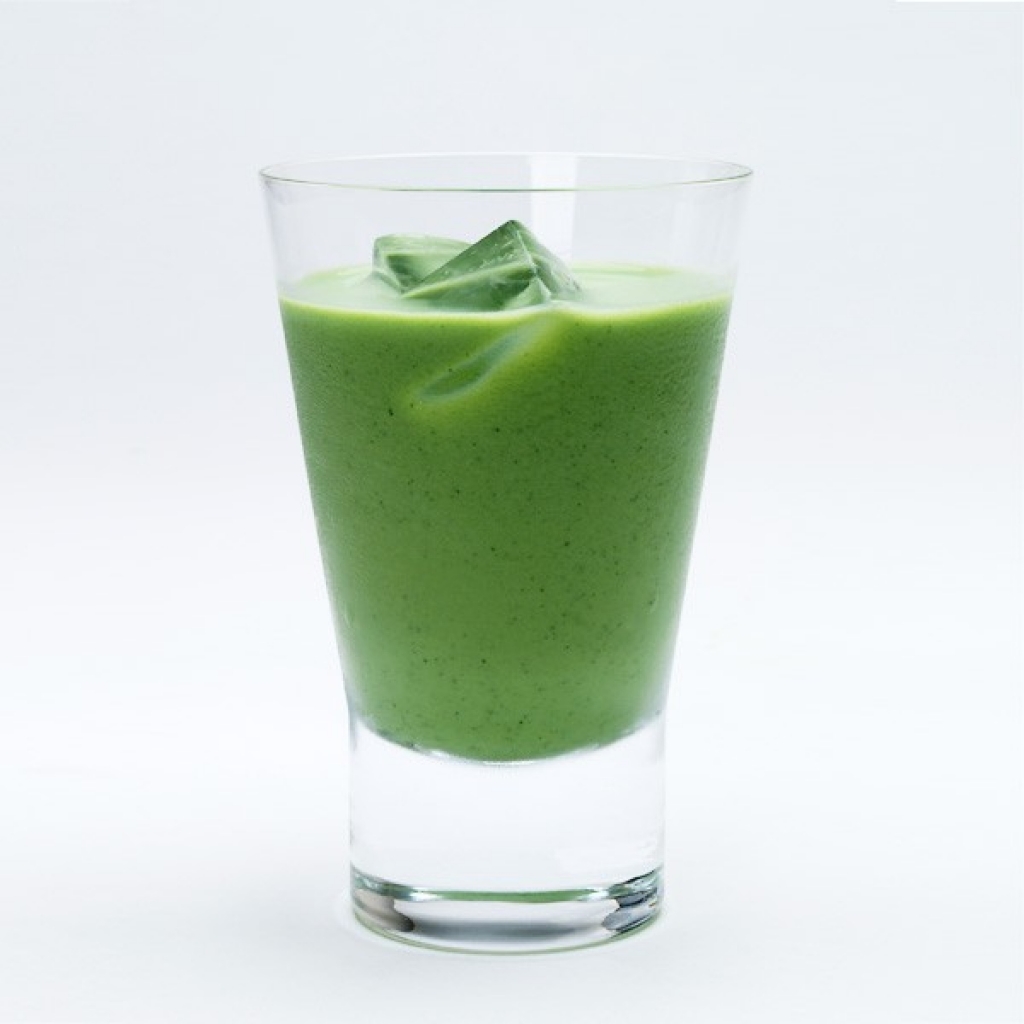 Sweetened Matcha – Designed For Milk by Marukyu Koyamaen
Sweetened Matcha – Designed For Milk by Marukyu Koyamaen
☞ 5 x 10 g sachets > $4.32
☞ 10 x 10 g sachets > $7.02
☞ 200 g Branded bag > $8.10
☞ 250 g Branded can > $12.96
☞ 1000 g Branded bag > $32.40
➤ HOW TO MAKE COLD MATCHA
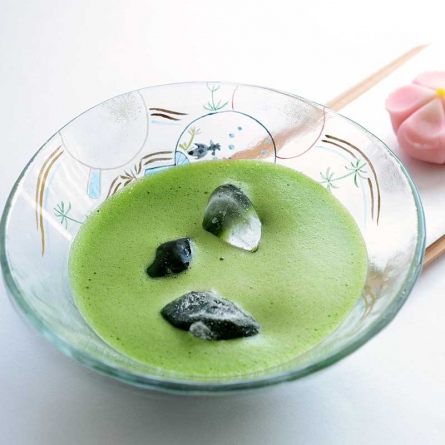 1 ➢ Put 2 g (0.4 US tsp, 1 teaspoon, or 2 chashaku scoops) matcha powder into a suitable chawan (tea bowl).
1 ➢ Put 2 g (0.4 US tsp, 1 teaspoon, or 2 chashaku scoops) matcha powder into a suitable chawan (tea bowl).
2 ➢ Pour about 80 ml (2.5 fl oz) cold water or once boiled but cooled down water over the matcha powder.
3 ➢ Whisk with a chasen (tea whisk) until foamy.
4 ➢ Add some ice.
Recommended tools:
Hira chawan or glass chawan and Chasen Hachijuppondate Kubo Tetsuzo or Shin Chasen Kubo Sabun
➤ HOW TO MAKE SWEET GREEN TEA
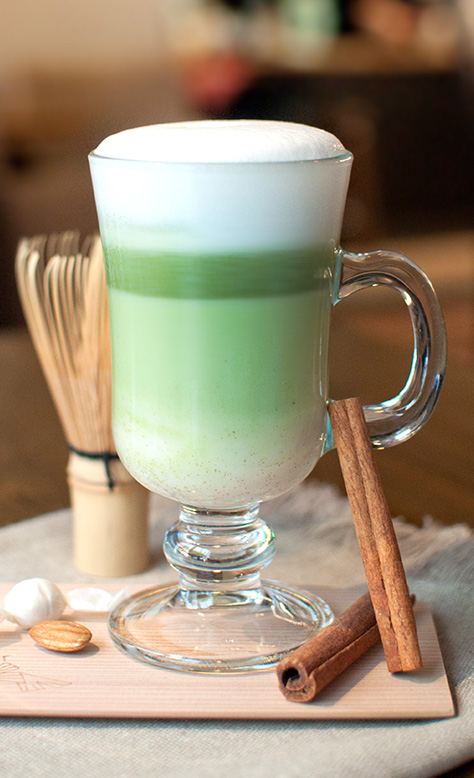
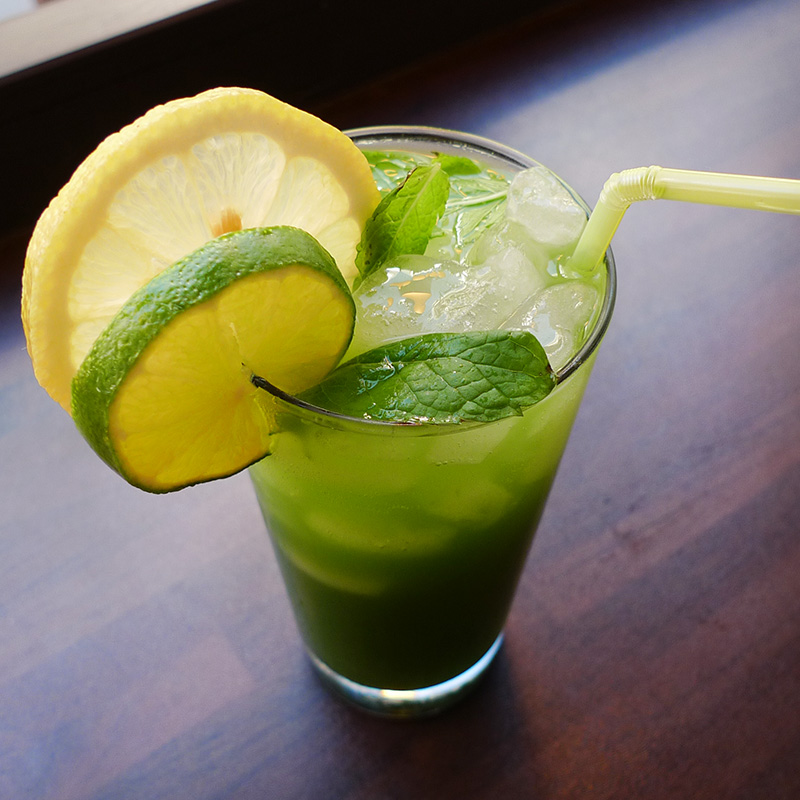
1 ➢ Put 20 g (4 US tsp) sweetened matcha into your cup.
2 ➢ Pour in about 150 ml (5 fl oz) of cold water (or any kind of milk you like, e.g. normal, soy, almond, etc.).
3 ➢ Mix well and add ice.
TIP: For matcha lemonade, prepare it with still water or soda and add mint, herbals, or lemon juice to taste.
Every year, some matcha makers come out with seasonal matcha blends inspired by the summer. These matcha teas are made with hot water then poured over ice, and are only available in summer.
Yamamasa Koyamaen offers:
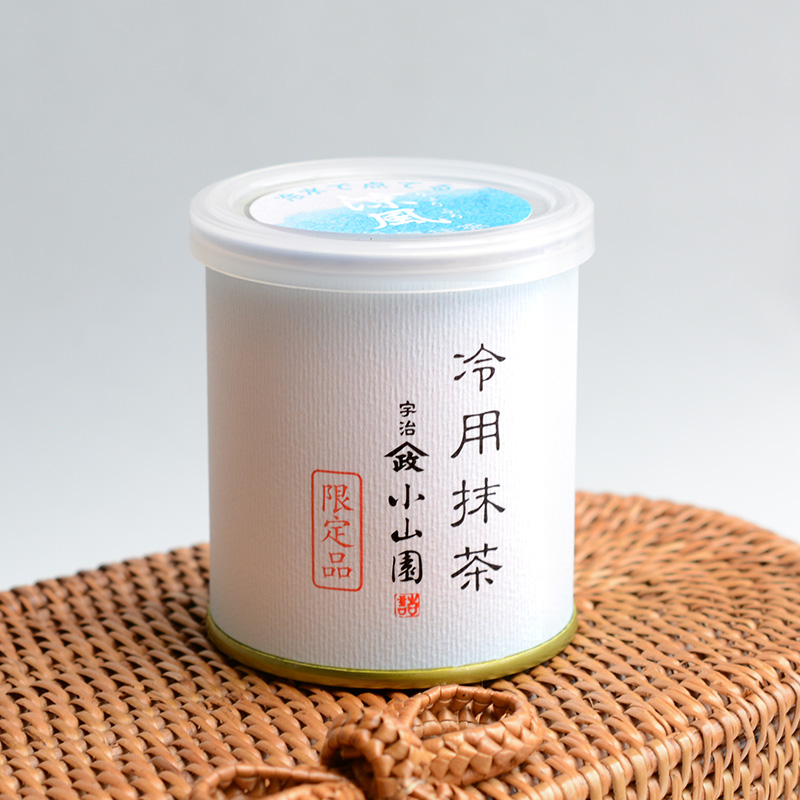 Reiyou Matcha
Reiyou Matcha
Matcha with a pleasantly refreshing, creamy taste. The manufacturer also recommends it prepared with cold water.
☞ 30 g Branded CAN > $16.20
Horii Shichimeien offers:
 Matcha Seseragi no Shiro
Matcha Seseragi no Shiro
Usucha grade matcha blend created by Horii Chōjirō, a highly respected tea master and owner of Horii Shichimein. It has a smooth, well-rounded taste.
☞ 30 g Branded CAN > $23.76
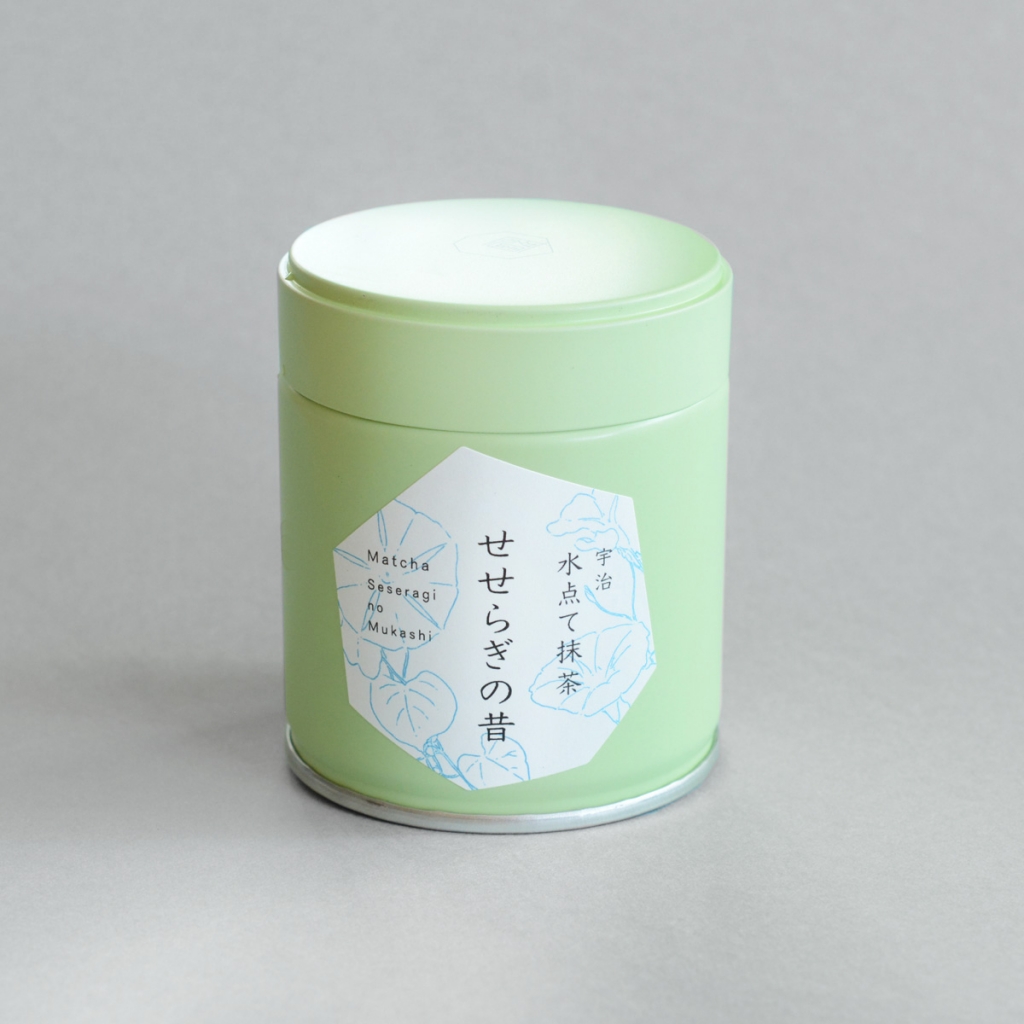 Matcha Seseragi no Mukashi
Matcha Seseragi no Mukashi
Koicha grade matcha was also created by Horii Chōjirō. Seseragi no Mukashi is made of Samidori cultivar. It is a higher grade than Seseragi no Shiro, with a more complex, sweet, fruity, smooth flavor.
☞ 30 g Branded CAN > $35.64
HOW TO MAKE ICED MATCHA
1 ➢ Put 2 g (0.4 US tsp, 1 teaspoon, or 2 chashaku scoops) sifted matcha powder into a tea bowl.
2 ➢ Pour 30 ml (1 fl oz) of about 40℃ (104°F) water over the matcha powder.
3 ➢ Whisk with a chasen (tea whisk) until foamy.
4 ➢ Put ice cubes into the ready matcha and enjoy it cold.
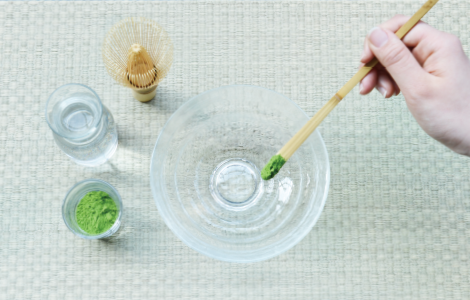
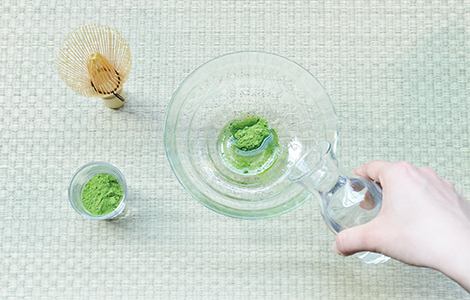
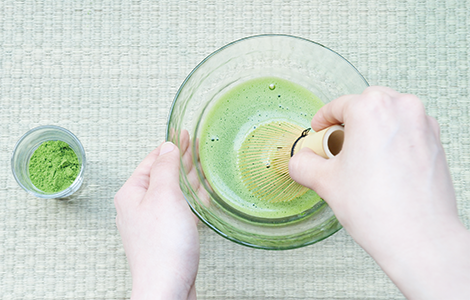
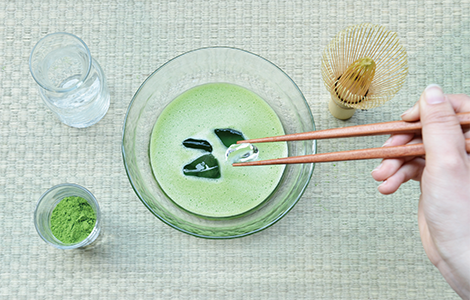
Recommended tools:
Hira chawan or glass chawan and Shin Chasen Kubo Sabun
Loose-leaf teas are usually made hot, but some are exceptionally delicious when you cool them down with ice. They have a more intense flavor with a fresh, astringent touch.
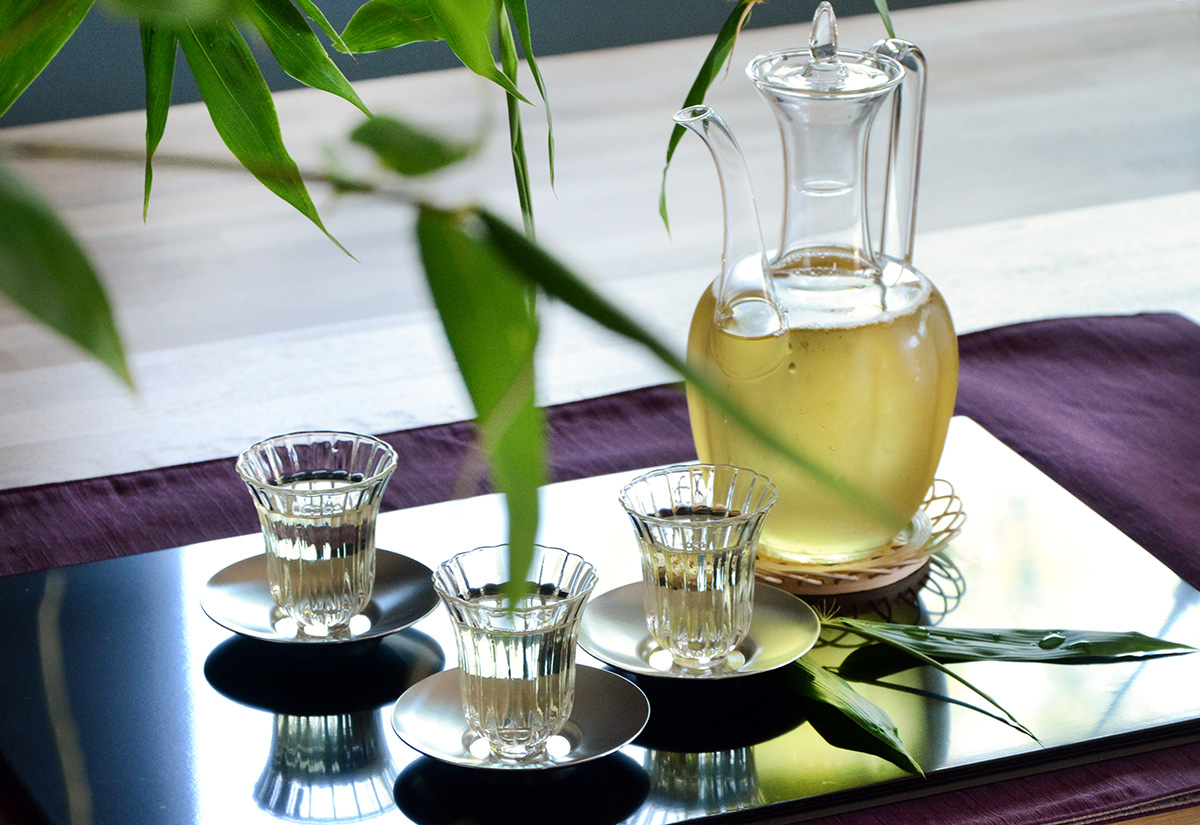
Recommendations from SAZEN's original selection:
 Chiran Tokujō Fukamushicha ⎼ Japanese Green Tea
Chiran Tokujō Fukamushicha ⎼ Japanese Green Tea
This premium fukamushicha is made of high-quality green tea leaves exposed to direct sunlight. After the harvest, the tea is steamed longer, which results in fine leaves, more tea dust, rich umami, and a relatively high caffeine level.
☞ 100 g Sazen BAG > $19.44
☞ 200 g Sazen BAG > $37.80
☞ 500 g BULK > $86.40
 Matcha iri Genmaicha Genmyo ⎼ Japanese Green Tea Blended with Rice
Matcha iri Genmaicha Genmyo ⎼ Japanese Green Tea Blended with Rice
A special gourmet blend of sencha leaves, powdered green tea, and roasted brown rice. Tea bushes are exposed to direct sunlight, therefore the taste is characteristic and refreshing with a very pleasant roasted aroma of brown rice. It is a well-vitalizing tea with a nice fragrance.
☞ 100 g Sazen BAG > $9.72
☞ 200 g Sazen BAG > $18.36
☞ 500 g BULK > $41.04
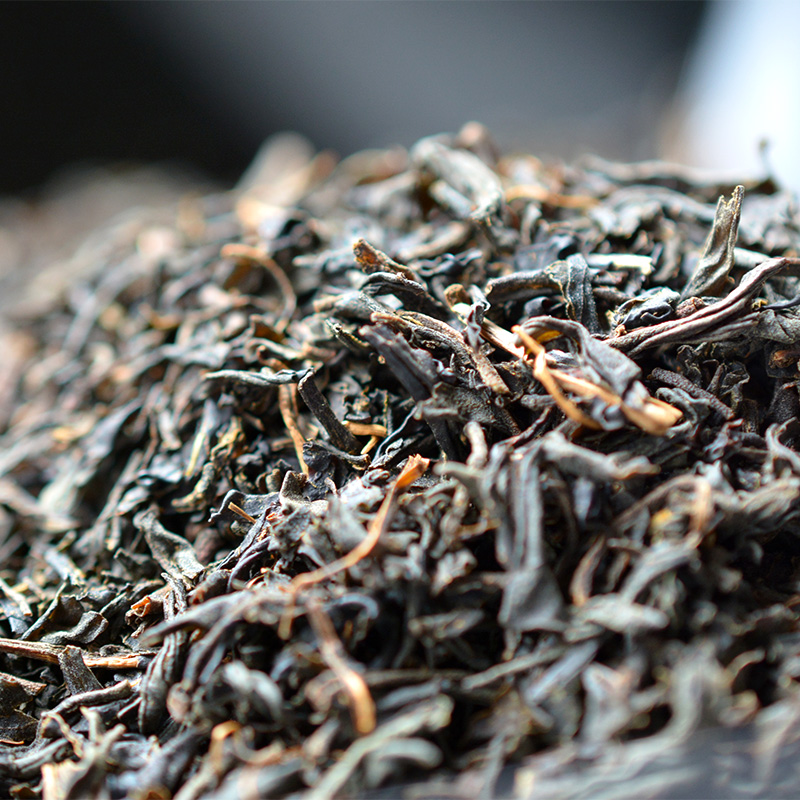 Yame Koucha ⎼ Japanese Black Tea
Yame Koucha ⎼ Japanese Black Tea
This tea is rich in flavor and has a pleasant, sweet, fruity aftertaste.
Yame is mostly known for its Gyokuro, but the area is producing excellent black teas as well, cultivated from native Japanese tea cultivars. These cultivars are famous for being sweet without any lingering bitterness. A charismatic tea that is also exceptionally rich in antioxidants.
☞ 50 g Sazen BAG > $9.72
☞ 100 g Sazen BAG > $17.82
☞ 500 g BULK > $77.76
 Kabusecha Akamine ⎼ Japanese Green Tea
Kabusecha Akamine ⎼ Japanese Green Tea
Kabusecha means "shaded tea". About a week before picking tea leaves, tea fields are directly covered to protect them from the sunlight. Thanks to this method, kabusecha has a sweet and mellow taste with refreshing green notes.
☞ 100 g Sazen BAG > $19.44
☞ 200 g Sazen BAG > $37.80
☞ 500 g BULK > $86.40
 Uji Karigane Wakatake ⎼ Japanese Green Tea
Uji Karigane Wakatake ⎼ Japanese Green Tea
Karigane is a tea where tea leaves and tea stems are mixed.
It contains more vitamin C than other types of green tea and has a mildly bitter, slightly creamy taste. Uji Karigane is made of Sencha when the tea bushes are exposed to direct sunlight, that is why its taste has a characteristic refreshing flavor with a nice ‘green’ aftertaste.
☞ 100 g Sazen BAG > $10.80
☞ 200 g Sazen BAG > $21.60
☞ 500 g BULK > $48.60
HOW TO MAKE ICED LOOSE LEAF TEA
1 ➢ Put 8 g (2 US tsp) of tea leaves into a large teapot.
2 ➢ Cool down boiled water to 85℃ (185ºF) and pour 250 ml (8.5 fl oz) into the teapot.
3 ➢ Steep for 50 seconds.
4 ➢ Fill a large pitcher (about the capacity of half a liter) and pour the tea over it.
5 ➢ Make another infusion, with 200 ml (6.7 fl oz) water, 50℃ (122ºF) water, and 1-minute steeping time.
6 ➢ Pour it into the same pitcher to mix the two infusions and enjoy it cold.
Recommended tools: Ocean Rich Tea Dripper
A stylish and modern tea dripper, great for busy mornings, lazy afternoons, and office tea sessions. Also convenient for everyone who has just started their tea journey. The dripper is a must-have in summer. Just put ice in a pitcher or a large cup, let the tea dripper do its job, and your iced tea is ready!



Mizudashi means cold-brew tea in Japanese. Teas can have multiple characters. Tea prepared with cold water is amazingly refreshing with taste notes and aromas we might not get brewing them in hot water. Cold-brew tea is generally pleasant, mild, and sweet, especially compared to teas prepared with the above-mentioned iced tea method.
For this technique, we recommend Japanese, Chinese, and Taiwanese teas as well.
Recommended Japanese Teas for cold brewing:
- Gyokuro Takamine
Green tea from shaded tea fields with a rich umami flavor, produced in Ujitawara, the southern part of Kyoto.
- Gyokuro Karigane Ayatake
Tea stems blended with tasteful green tea from shaded tea fields in Kyoto, Japan. As a Karigane, it has a milder, sweeter taste.
- Tongu Asutsuyu
Single-origin green tea cultivar with a roasted sweet potato aroma.
- Tongu Saemidori
Single-origin green tea cultivar with a rich and sweet flavor, a fresh, grassy aroma, and a lemongrass aftertaste.
- Ureshino Kamairicha
Characteristic pan-fried green tea from Saga Prefecture, Japan
- Sencha Houjicha
Sencha Hōjicha is a roasted green tea made exclusively from first-flush green tea leaves, and this is very much palpable in its freshness. It has a wonderful roasted taste.
- Koucha Houjicha
Roasted black tea. It is fruity and amazingly sweet, with candy cane and honey notes present in both the fragrance and the flavor.
Recommended Chinese Teas for cold brewing:
- Mo Li Hua Cha
Green tea produced in Fujian Province, scented 8 times by quality, fresh jasmine flowers.
- Bai Mudan (White Peony)
A refreshing, rich, and sweet-tasting white tea from Fujian Province, made from only the freshest tea buds and 1 or 2 of the leaves right under the bud.
- Feng Huang Dancong Mi Lan Xiang
Oolong tea from the Phoenix Mountains. The fragrance recalls orchid flowers with the thick aroma of flower honey and the forward note of passion fruit that appears a little later but stays the longest.
- Meng Ding Lan Fei
This tea is harvested on the Meng Ding Mountain, at an over 1000 meter altitude. Meng Ding Lan Fei is a silky, sweet, and floral tea with a lasting spicy and verdant aftertaste. Lan Fei's leaves are already a sight to behold and it is generally famous for standing out with its strong magnolia aromas.
- Dong Ting Bi Luo Chun
Dong Ting Bi Luo Chun from Suzhou City, Jiangsu Province is known as one of the great representatives of Chinese green tea because of its rich aromas, sweet aftertaste, and stunning appearance.
Recommended Taiwanese Teas for cold brewing:
- Dong Fang Meiren Superior (Oriental Beauty)
Rare Taiwanese oolong tea made in only one tea farm in Taiwan and picked within one week in early June. Has the aroma of ripe fruit and honey, with a flavor like red tea.
HOW TO MAKE ICED LOOSE LEAF TEA
1 ➢ Put 10 g (2 US tsp) of tea leaves in a large tea maker.
2 ➢ Fill your vessel (or tea maker) with cold water (about 800–1000 ml).
3 ➢ Put the vessel in the fridge and wait for at least 4 hours and enjoy it cold.
TIP ★ Prepare it in the evening before going to bed, so you can start the morning with a refreshing cup of mizudashi iced tea.
TIP ★ Flavor it with mint, lemongrass, etc.
TIP ★ You can make one more infusion, steeping time: 1–2 hours.
Recommended tools: HARIO Mizudashi tea maker or Tea drip and Pine Needle Teacup
To bring the best out of your summer tea, you need suitable tools. Some of them are summer tools by function, some by design, but they are all delightful addition to your summer tea time.
Hira chawan
“Hira” refers to the shape of the chawan: broad and flat. This shape, with its wide and open mouth, helps the matcha cool faster. With ice in it, it makes the perfect summer matcha.
Glass chawan
Cold touch and cool sight, a glass chawan brings a little extra to the summer tea times, especially when you add some ice to it.
Gokuhira and Hiramaru Kyusu
These flat teapots are ideal to make cold loose leaf tea. Either you prepare it with hot water and then cool it down, or you make mizudashi with the ice slowly melting and dripping on the leaves, these teapots are great additions to any tea lover’s collection.
Futanashi Kyusu
Futanashi kyusu is a lidless teapot. Without a lid that keeps the steam in, the tea can cool down faster. Also, since you can see the tea leaves opening, you know when your tea is ready.
HARIO Mizudashi tea maker and Tea dripper
HARIO Mizudashi tea maker and Tea dripper are both excellent tools to make mizudashi tea for a larger group of people. Excellent for tea parties.
Twistea
The perfect tool to make iced tea on the go. All you need is a twist to separate the tea leaves from the water. This way, you can make several infusions.
Accessories
Glass - Find the best glass accessories to make your summer tea time perfect.
Trays - Serve teas on beautiful wooden trays for elegance.
Teacups - No tea time can be complete without the perfect teacup, regardless of the season.
Yuzamashi (pitcher) - Use a yuzamashi to cool down the water and make the most delicious teas.
Summer decorations
Summer is a season of lots of colors and delight. Some of the popular summer motives are summer plants such as Ajisai (hydrangea), Aomomiji (green maple leaves), Kikyou (bellflower), Asagao (morning glory), Himawari (sunflower), Yanagi (willow), natural elements like Mizu (water) and Nyuudougumo (thunderhead), summer ornaments like Fuurin (windchimes), summer festival funs like Hanabi (fireworks) or Senkōhanabi (firecracker), and animals like Hotaru (firefly), Kingyo (goldfish), Semi (cicada), and Kaeru (frog).
Did you find this blog useful? (135)


 Matcha Awaraku
Matcha Awaraku Matcha Suzukumo
Matcha Suzukumo Sweet Green Tea by Hekisuien
Sweet Green Tea by Hekisuien
 Sweetened Matcha – Designed For Milk by Marukyu Koyamaen
Sweetened Matcha – Designed For Milk by Marukyu Koyamaen 1 ➢ Put 2 g (0.4 US tsp, 1 teaspoon, or 2 chashaku scoops) matcha powder into a suitable chawan (tea bowl).
1 ➢ Put 2 g (0.4 US tsp, 1 teaspoon, or 2 chashaku scoops) matcha powder into a suitable chawan (tea bowl).

 Reiyou Matcha
Reiyou Matcha Matcha Seseragi no Shiro
Matcha Seseragi no Shiro Matcha Seseragi no Mukashi
Matcha Seseragi no Mukashi




 Chiran Tokujō Fukamushicha ⎼ Japanese Green Tea
Chiran Tokujō Fukamushicha ⎼ Japanese Green Tea Matcha iri Genmaicha Genmyo ⎼ Japanese Green Tea Blended with Rice
Matcha iri Genmaicha Genmyo ⎼ Japanese Green Tea Blended with Rice Yame Koucha ⎼ Japanese Black Tea
Yame Koucha ⎼ Japanese Black Tea Kabusecha Akamine ⎼ Japanese Green Tea
Kabusecha Akamine ⎼ Japanese Green Tea Uji Karigane Wakatake ⎼ Japanese Green Tea
Uji Karigane Wakatake ⎼ Japanese Green Tea



